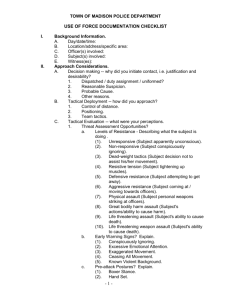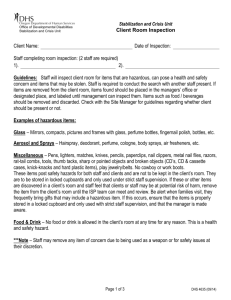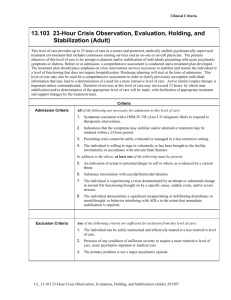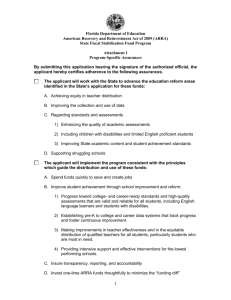Continuous Beer Stabilization – For improved Process Economics and Environmental Protection Summary
advertisement
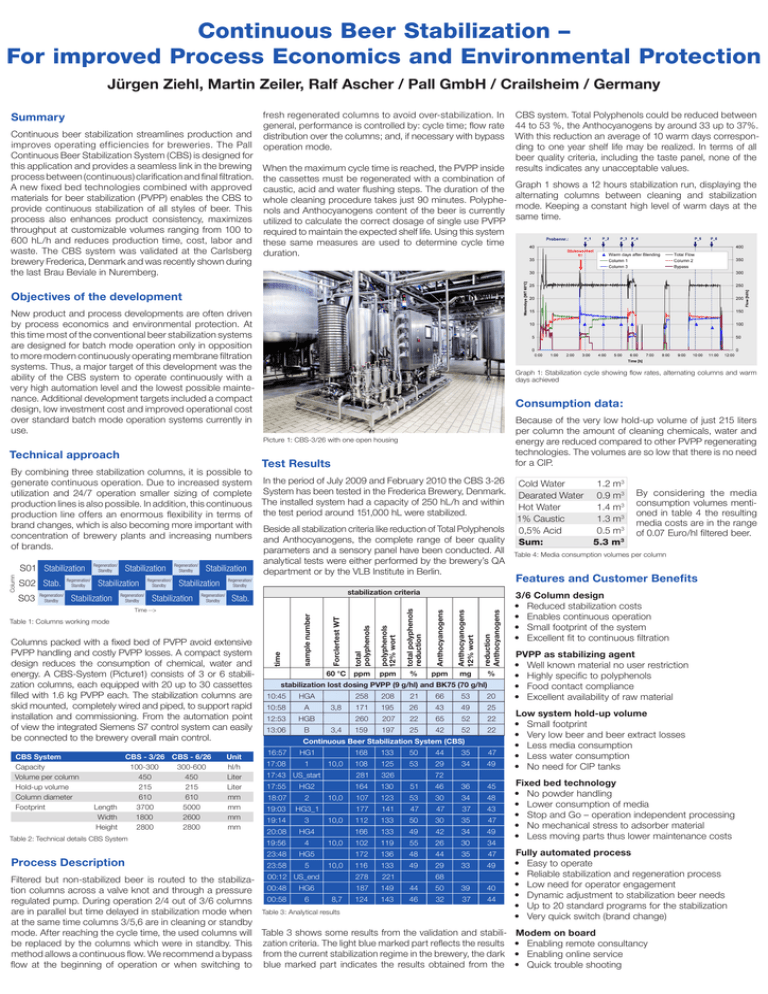
Continuous Beer Stabilization – For improved Process Economics and Environmental Protection Jürgen Ziehl, Martin Zeiler, Ralf Ascher / Pall GmbH / Crailsheim / Germany Summary Continuous beer stabilization streamlines production and improves operating efficiencies for breweries. The Pall Continuous Beer Stabilization System (CBS) is designed for this application and provides a seamless link in the brewing process between (continuous) clarification and final filtration. A new fixed bed technologies combined with approved materials for beer stabilization (PVPP) enables the CBS to provide continuous stabilization of all styles of beer. This process also enhances product consistency, maximizes throughput at customizable volumes ranging from 100 to 600 hL/h and reduces production time, cost, labor and waste. The CBS system was validated at the Carlsberg brewery Frederica, Denmark and was recently shown during the last Brau Beviale in Nuremberg. fresh regenerated columns to avoid over-stabilization. In general, performance is controlled by: cycle time; flow rate distribution over the columns; and, if necessary with bypass operation mode. When the maximum cycle time is reached, the PVPP inside the cassettes must be regenerated with a combination of caustic, acid and water flushing steps. The duration of the whole cleaning procedure takes just 90 minutes. Polyphenols and Anthocyanogens content of the beer is currently utilized to calculate the correct dosage of single use PVPP required to maintain the expected shelf life. Using this system these same measures are used to determine cycle time duration. CBS system. Total Polyphenols could be reduced between 44 to 53 %, the Anthocyanogens by around 33 up to 37%. With this reduction an average of 10 warm days corresponding to one year shelf life may be realized. In terms of all beer quality criteria, including the taste panel, none of the results indicates any unacceptable values. Graph 1 shows a 12 hours stabilization run, displaying the alternating columns between cleaning and stabilization mode. Keeping a constant high level of warm days at the same time. Objectives of the development New product and process developments are often driven by process economics and environmental protection. At this time most of the conventional beer stabilization systems are designed for batch mode operation only in opposition to more modern continuously operating membrane filtration systems. Thus, a major target of this development was the ability of the CBS system to operate continuously with a very high automation level and the lowest possible maintenance. Additional development targets included a compact design, low investment cost and improved operational cost over standard batch mode operation systems currently in use. Graph 1: Stabilization cycle showing flow rates, alternating columns and warm days achieved Consumption data: Picture 1: CBS-3/26 with one open housing Technical approach Test Results Column By combining three stabilization columns, it is possible to generate continuous operation. Due to increased system In the period of July 2009 and February 2010 the CBS 3-26 utilization and 24/7 operation smaller sizing of complete System has been tested in the Frederica Brewery, Denmark. production lines is also possible. In addition, this continuous The installed system had a capacity of 250 hL/h and within production line offers an enormous flexibility in terms of the test period around 151,000 hL were stabilized. brand changes, which is also becoming more important with Beside all stabilization criteria like reduction of Total Polyphenols concentration of brewery plants and increasing numbers and Anthocyanogens, the complete range of beer quality of brands. parameters and a sensory panel have been conducted. All analytical tests were either performed by the brewery’s QA Regeneration/ Regeneration/ S01 Stabilization Standby Stabilization Standby Stabilization department or by the VLB Institute in Berlin. Regeneration/ Regeneration/ S02 Stab. Regeneration/ Stabilization Stabilization Standby Standby Standby S03 Regeneration/ Standby Stabilization Regeneration/ Standby Stabilization Regeneration/ Standby stabilization criteria Stab. CBS System Capacity Volume per column Hold-up volume Column diameter Footprint Length Width Height CBS - 3/26 CBS - 6/26 100-300 300-600 450 450 215 215 610 610 3700 5000 1800 2600 2800 2800 Unit hl/h Liter Liter mm mm mm mm Table 2: Technical details CBS System Process Description Filtered but non-stabilized beer is routed to the stabilization columns across a valve knot and through a pressure regulated pump. During operation 2/4 out of 3/6 columns are in parallel but time delayed in stabilization mode when at the same time columns 3/5,6 are in cleaning or standby mode. After reaching the cycle time, the used columns will be replaced by the columns which were in standby. This method allows a continuous flow. We recommend a bypass flow at the beginning of operation or when switching to Forclertest WT total polyphenols polyphenols 12% wort total polyphenols reduction Anthocyanogens Anthocyanogens 12% wort reduction Anthocyanogens Columns packed with a fixed bed of PVPP avoid extensive PVPP handling and costly PVPP losses. A compact system design reduces the consumption of chemical, water and energy. A CBS-System (Picture1) consists of 3 or 6 stabilization columns, each equipped with 20 up to 30 cassettes filled with 1.6 kg PVPP each. The stabilization columns are skid mounted, completely wired and piped, to support rapid installation and commissioning. From the automation point of view the integrated Siemens S7 control system can easily be connected to the brewery overall main control. time Table 1: Columns working mode sample number Time --> 60 °C ppm ppm % ppm mg % stabilization lost dosing PVPP (9 g/hl) and BK75 (70 g/hl) 10:45 HGA 10:58 A 12:53 HGB 13:06 B 3,8 3,4 258 208 21 66 53 20 171 195 26 43 49 25 260 207 22 65 52 22 159 197 25 42 52 22 Continuous Beer Stabilization System (CBS) 16:57 HG1 168 133 50 44 35 47 17:08 1 108 125 53 29 34 49 17:43 US_start 281 326 17:55 HG2 164 130 51 46 36 45 18:07 2 107 123 53 30 34 48 19:03 HG3_1 177 141 47 47 37 43 19:14 3 112 133 50 30 35 47 20:08 HG4 166 133 49 42 34 49 19:56 4 102 119 55 26 30 34 23:48 HG5 172 136 48 44 35 47 23:58 5 116 133 49 29 33 49 00:12 US_end 278 221 00:48 HG6 187 149 44 50 39 40 00:58 6 124 143 46 32 37 44 10,0 10,0 10,0 10,0 10,0 8,7 72 68 Table 3: Analytical results Table 3 shows some results from the validation and stabilization criteria. The light blue marked part reflects the results from the current stabilization regime in the brewery, the dark blue marked part indicates the results obtained from the Because of the very low hold-up volume of just 215 liters per column the amount of cleaning chemicals, water and energy are reduced compared to other PVPP regenerating technologies. The volumes are so low that there is no need for a CIP. Cold Water 1.2 m3 Dearated Water 0.9 m3 Hot Water 1.4 m3 1% Caustic 1.3 m3 0,5% Acid 0.5 m3 Sum: 5.3 m3 By considering the media consumption volumes mentioned in table 4 the resulting media costs are in the range of 0.07 Euro/hl filtered beer. Table 4: Media consumption volumes per column Features and Customer Benefits 3/6 Column design •Reduced stabilization costs •Enables continuous operation •Small footprint of the system •Excellent fit to continuous filtration PVPP as stabilizing agent •Well known material no user restriction •Highly specific to polyphenols •Food contact compliance •Excellent availability of raw material Low system hold-up volume •Small footprint •Very low beer and beer extract losses •Less media consumption •Less water consumption •No need for CIP tanks Fixed bed technology •No powder handling •Lower consumption of media •Stop and Go – operation independent processing •No mechanical stress to adsorber material •Less moving parts thus lower maintenance costs Fully automated process •Easy to operate •Reliable stabilization and regeneration process •Low need for operator engagement •Dynamic adjustment to stabilization beer needs •Up to 20 standard programs for the stabilization •Very quick switch (brand change) Modem on board •Enabling remote consultancy •Enabling online service •Quick trouble shooting



